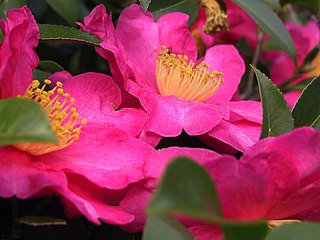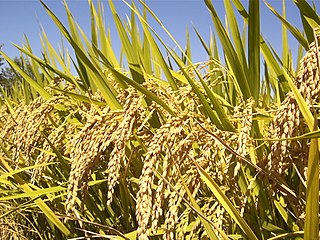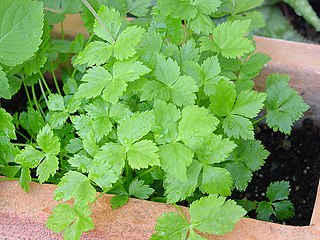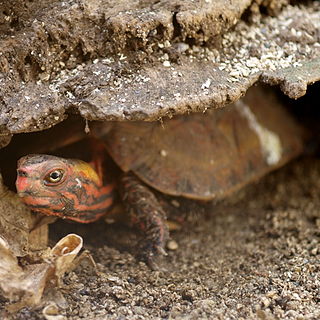
Camellia is a genus of flowering plants in the family Theaceae. They are found in eastern and southern Asia, from the Himalayas east to Japan and Indonesia. There are 100–300 described species, with some controversy over the exact number. There are also around 3,000 hybrids. The genus was named by Linnaeus after the Jesuit botanist Georg Joseph Kamel, who worked in the Philippines and described a species of camellia. Camellias are famous throughout East Asia; they are known as cháhuā in Chinese, tsubaki (椿) in Japanese, dongbaek-kkot (동백꽃) in Korean, and as hoa trà or hoa chè in Vietnamese.

The Japanese beetle is a species of scarab beetle. The adult measures 15 mm (0.6 in) in length and 10 mm (0.4 in) in width, has iridescent copper-colored elytra and a green thorax and head. It is not very destructive in Japan, where it is controlled by natural predators, but in North America, it is a noted pest of about 300 species of plants including rose bushes, grapes, hops, canna, crape myrtles, birch trees, linden trees, and others.

Cryptomeria is a monotypic genus of conifer in the cypress family Cupressaceae, formerly belonging to the family Taxodiaceae. It includes only one species, Cryptomeria japonica. It is endemic to Japan, where it is known as sugi. The tree is called Japanese cedar or Japanese redwood in English.

Chaenomeles is a genus of three species of deciduous spiny shrubs, usually 1–3 m tall, in the family Rosaceae. They are native to Japan, Korea, China, Bhutan, and Burma. These plants are related to the quince and the Chinese quince, differing in the serrated leaves that lack fuzz, and in the flowers, borne in clusters, having deciduous sepals and styles that are connate at the base.

Lonicera japonica, known as Japanese honeysuckle and golden-and-silver honeysuckle, is a species of honeysuckle native to eastern Asia including China, Japan, and Korea. It is a twining vine able to climb up to 10 m (33 ft) high or more in trees, with opposite, simple oval leaves 3–8 cm (1.2–3.1 in) long and 2–3 cm (0.79–1.18 in) broad. The flowers are double-tongued, opening white and fading to yellow, and sweetly vanilla scented. The fruit is a black spherical berry 3–4 mm (0.12–0.16 in) diameter containing a few seeds.

The loquat is a species of flowering plant in the family Rosaceae, a native to the cooler hill regions of China to south-central China. It is also quite common in Japan, Korea, hilly Regions of India (Himachal), Potohar and foothill regions of Pakistan and some can be found in some Northern part of the Philippines, and hill country in Sri Lanka. It can also be found in some southern European countries such as Turkey, Cyprus, Greece, Malta, Italy, Albania, Spain and Portugal; and several Middle Eastern countries including Morocco, Algeria, Iran, Syria, Iraq, Jordan, Israel and Lebanon.

Oryza sativa, commonly known as Asian rice, is the plant species most commonly referred to in English as rice. Oryza sativa is a grass with a genome consisting of 430Mb across 12 chromosomes. It is renowned for being easy to genetically modify, and is a model organism for cereal biology.

Camellia japonica, known as common camellia, Japanese camellia, or tsubaki in Japanese, is one of the best known species of the genus Camellia. Sometimes called the rose of winter, it belongs to the family Theaceae. It is the official state flower of Alabama. There are thousands of cultivars of C. japonica in cultivation, with many different colors and forms of flowers.

Cryptotaenia, also honewort, is a genus of herbaceous perennial plants, native to North America, Africa, and eastern Asia, growing wild in moist, shady places.

Ulmus davidiana var. japonica, the Japanese elm, is one of the larger and more graceful Asiatic elms, endemic to much of continental northeast Asia and Japan, where it grows in swamp forest on young alluvial soils, although much of this habitat has now been lost to intensive rice cultivation.
Japonica refers to things related to Japan.

The Ryukyu black-breasted leaf turtle or Ryukyu leaf turtle, Geoemyda japonica, is a species of turtles in the family Geoemydidae endemic to the Ryukyu Islands in Japan. In 1975, the species was designated a National Natural Monument of Japan. It grows to about 5–6 inches long. In captivity, it feeds on worms, snails, insects, and fruit. Due to its rarity and very attractive appearance, this species is highly coveted by turtle collectors worldwide.

The Japanese pond turtle is a species of turtle in the family Geoemydidae endemic to Japan. Its Japanese name is nihon ishigame, Japanese stone turtle. Its population has decreased somewhat due to habitat loss, but it is not yet considered a threatened species.

Surugatoxin (SGTX) is a type of venom found in the mid-gut digestive gland of the Japanese ivory mollusk Babyloniajaponica, a carnivorous gastropod. It functions as a ganglionic blocker of nicotinic acetylcholine receptors (nAChRs). The structurally and functionally related neosurugatoxin, also derived from Babylonia japonica, is an even more potent nAChR antagonist than SGTX.

Japonica rice, sometimes called sinica rice, is one of the two major domestic varieties of Asian rice. Japonica rice is extensively cultivated and consumed in China, Japan, Korea, and Taiwan, whereas in most other regions Indica rice is the dominant type of rice.
The natural hybrid elm Ulmus×mesocarpaM. Kim & S. Lee is a cross of Ulmus macrocarpa with Japanese Elm Ulmus davidiana var. japonica discovered on Seoraksan near the city of Sokcho on the eastern coast of South Korea. The tree is endemic to the provinces of Gangwon-do, Injegun, Bukmyeon, Yongdaeri, and Baekdamsa.
Rickettsia japonica is a species of Rickettsia. It can cause Japanese spotted fever.

Teniloxazine, also known as sufoxazine and sulfoxazine, is a drug which is marketed in Japan. Though initially investigated as a neuroprotective and nootropic agent for the treatment of cerebrovascular insufficiency in the 1980s, it was ultimately developed and approved as an antidepressant instead. It acts as a potent norepinephrine reuptake inhibitor, with fair selectivity over the serotonin and dopamine transporters, and also behaves as an antagonist of the 5-HT2A receptor.

Pterolophia is a genus of longhorn beetles of the subfamily Lamiinae, containing the following species:

















